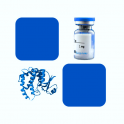
- Remove this product from my favorite's list.
- Add this product to my list of favorites.
Products
Viewed products
Newsletter
 |  |  |  |  |  |

Background
Transforming growth factor beta 1 ( TGFB1) is also known as TGF-β1, CED, DPD1, TGFB. is a polypeptide member of the transforming growth factor beta superfamily of cytokines. It is a secreted protein that performs many cellular functions, including the control of cell growth, cell proliferation, cell differentiation and apoptosis. The TGFB1 protein helps control the growth and division (proliferation) of cells, the process by which cells mature to carry out specific functions (differentiation), cell movement (motility), and the self-destruction of cells (apoptosis). The TGFB1 protein is found throughout the body and plays a role in development before birth, the formation of blood vessels, the regulation of muscle tissue and body fat development, wound healing, and immune system function. TGFB1 is particularly abundant in tissues that make up the skeleton, where it helps regulate bone growth, and in the intricate lattice that forms in the spaces between cells (the extracellular matrix). Within cells, this protein is turned off (inactive) until it receives a chemical signal to become active. TGFB1 plays an important role in controlling the immune system, and shows different activities on different types of cell, or cells at different developmental stages. Most immune cells (or leukocytes) secrete TGFB1. TGFB1 has been shown to interact with TGF beta receptor 1, LTBP1, YWHAE, EIF3I and Decorin.
Source
Recombinant Human Latent TGFB1, His Tag (TG1-H524x) is expressed from human 293 cells (HEK293). It contains AA Leu 30 - Ser 390 (Accession # P01137-1).
Predicted N-terminus: His
Molecular Characterization
This protein carries a polyhistidine tag at the N-terminus.
The protein has a calculated MW of 42.6 kDa (monomer). The protein migrates as 37-45 kDa (LAP) and 13 kDa (TGFB1) under reducing (R) condition (SDS-PAGE) due to glycosylation and Interchain disulfide bond.
Endotoxin
Less than 1.0 EU per μg by the LAL method.
Purity
>95% as determined by SDS-PAGE.
Formulation
Lyophilized from 0.22 μm filtered solution in PBS, pH7.4 with trehalose as protectant.
Reconstitution
Please see Certificate of Analysis for specific instructions.
For best performance, we strongly recommend you to follow the reconstitution protocol provided in the CoA.
Storage
For long term storage, the product should be stored at lyophilized state at -20°C or lower.
Please avoid repeated freeze-thaw cycles.
This product is stable after storage at:
-20°C to -70°C for 12 months in lyophilized state;
-70°C for 3 months under sterile conditions after reconstitution.
Bioactivity
Please refer to product data sheet.
(1) "A novel GARP humanized mouse model for efficacy assessment of GARP-targeting therapies"
Guo, Niu, Lv et al
Int Immunopharmacol (2024) 130, 111782
(2) "Engineered Surfaces That Promote Capture of Latent Proteins to Facilitate Integrin-Mediated Mechanical Activation of Growth Factors"
Dhawan, Williams, Windmill et al
Adv Mater (2024)
(3) "[The Role of TGF-β1/SMAD in Diabetic Nephropathy: Mechanisms and Research Development]"
Wang, Guo, Shao et al
Sichuan Da Xue Xue Bao Yi Xue Ban (2023) 54 (6), 1065-1073
Showing 1-3 of 1087 papers.
Follow us